By Jeffrey A. Rendall, Images Courtesy of the Leaderboard
CALIFON, NJ � Just glance at a list of entrants to any PGA Tour event, and you�ll discover Australia�s contribution to professional golf. Greg Norman may have brought prominence to the �Down Under� continent with his performances during the 80�s and 90�s, but it�s in the 21st century that Aussies as a group are really making their mark.
Through mid-June of 2006, four different Australian players have won five times on Tour, and that doesn�t even include Adam Scott, ranked in the World top ten and a constant contender nearly everywhere he tees it up. Likewise, LPGA member Karrie Webb has taken half of the season�s majors thus far, and finished second in the other.
Australia may have given us �Crocodile Dundee� Paul Hogan, Outback Steakhouse and Fosters beer, but it�s golf where the continent is making its biggest impact. And one of the reasons why is because of a new swing-aid device, known as the Leaderboard.
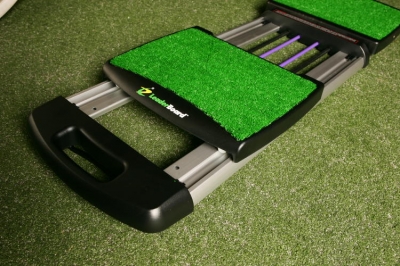 |
Swing-aids purport to cure just about everything that ails your sickly swing, but only a token few concentrate on the body fitness and posture aspect of the game. That�s where the Leaderboard sets itself apart.
The Leaderboard, invented in part and endorsed by Aussie PGA Tour pro Stuart Appleby, concentrates its focus on the musculature in your mid-section, and the all important balance aspect that�s essential to making a complete body turn, therefore allowing you to square the club at impact. The result is supposedly longer and straighter shots.
Appleby�s already won twice in 2006, and he explained how the Leaderboard�s helped him become one of the Tour�s most successful in recent years: �The biggest issue I was having in my golf swing was maintaining correct posture. It�s quite easy to do when you�re standing still, but dynamically, the swing changes. So I had a weakness, as most golfers do, in maintaining the proper shape through impact and the back swing.�
So many swing-aids are designed to �show� you something � the correct position of the golf club, the correct path it should take, and whether you�re releasing the club too early or late. The Leaderboard is different � it actually teaches you what a golf swing should �feel� like � and you can even use it with or without a golf club.
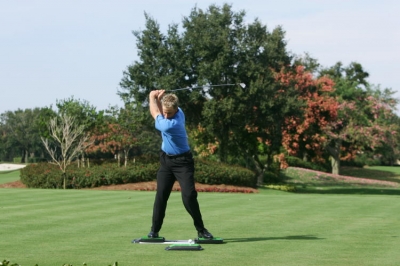 |
Again, Appleby explains: �The greatest thing about the Leaderboard is you can �feel� if you�re making the right swing. Teachers can always tell you certain things � if you�re putting, they can tell you to aim a foot to the right, you know how far to aim. A foot is a foot. But if I told you to hit something �this hard,� then that�s very hard to explain, because �this hard� is an emotion, a feeling.�
He continues, �But when I put you on the Leaderboard and say � see how it feels when you move the club this way, and you say �Oh my God, I�ve never felt that.� Most people like to have a feeling when they�re swinging the club. They obviously don�t like the bad ones. So when you can direct them towards what a correct �feel� is for the golf swing, then you�ve got a chance at improving your game.�
�We felt this was an avenue available for the average golfer to understand what it�s like to swing like a pro or understand the feelings that we have with our swing, and try to replicate that feeling and give it to an amateur,� Appleby added.
After all, there�s more to it than merely receiving a greeting card in the mail. You can�t package a �feeling,� and like Appleby says, trying to explain what something �feels like� is nearly impossible. In other art forms, we�ve left the concept to poets and song-writers to devise similes for our education. For golf, now we�ve got the Leaderboard to help out.
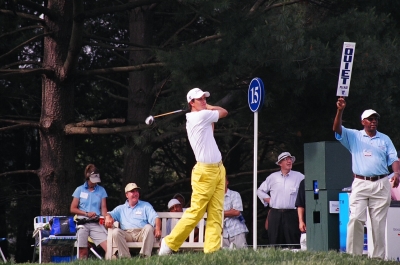 |
| From the 2005 Booz Allen Classic -- Adam Scott is another Australian player who uses the Leaderboard. |
Because the Leaderboard is designed to hold your weight, it�s larger and heavier than most other swing-aids. Comprised of two Astroturf covered boards called �skates� (one sliding on a metal track) which are connected by as many as four bungee-like cords -- you stand, one foot on each, and the cords provide the tension (when stretched) to accommodate your set-up, and release when you�re making a swing.
The latest �market ready� version of the Leaderboard is the end-result of several years of evolution. Appleby said the original design was very heavy, and not really conducive to encouraging average players to take it with them to the range, or use it at home on a regular basis. He�s an investor in the company that manufactures them, but insists that he�s not doing it for the prospect of profit.
Judging by the members of Appleby�s automobile collection, he�s already got all the money he needs.
�I�m doing this because I really believe in this product, and it�s like nothing else has ever been. It�s very unique. I think it�s a fantastic tool that I�ve given to amateurs to play with as much as use it regularly myself,� Appleby said.
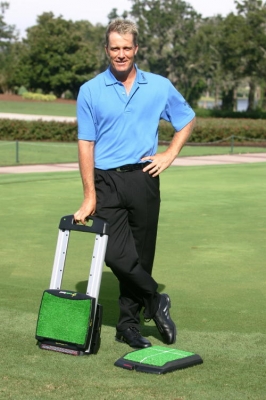 |
With a retail price of $200, the Leaderboard isn�t cheap, and thankfully for the mechanically challenged, comes complete with an instructional DVD �starring� Appleby, and a second DVD where he demonstrates several fitness workout moves that can be performed on the device.
Adding to the Down-Under flavor of The Leaderboard is its other corps of Australian endorsers, including Ian Baker-Finch, Adam Scott, Robert Allenby, and recent first-time winners Aaron Baddeley, Rod Pampling, and Geoff Ogilvy � though they claim that over 30 Tour pros (of all nationalities) use it and swear by it.
Putting the Leaderboard to the test, I�ve found it useful for convenience�s sake because it can easily be employed at home without the need to actually hit balls with it. One instructional aspect that was sadly lacking with the product shipment was a more detailed manual to suggest how much tension to begin with (i.e, the number of cords to attach), since the materials only tell you how to set it up with all four cables connected. The highest tension would be fine for the workout/fitness aspect of the device, but I found it extremely difficult if not impossible to actually set-up and swing with that much rigidity for a �normal� shot.
Maybe it�s because I wasn�t �fit� enough to begin with, but I do a fairly rigorous bike workout routine, so strength in the legs and torso are not a problem.
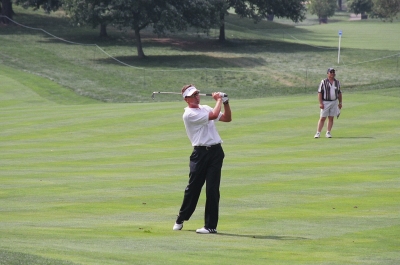 |
| Robert Allenby. |
As a result, there�s a fair amount of trial-and-error involved to find the happy medium in setting up the device. Once that was discovered, I found the Leaderboard very helpful in teaching the correct �feel� involved in transferring weight from your right to left sides during the golf swing. Maybe it�s because that�s a problem I�ve always had � in fear of hooking the ball � but this seemed to be where the Leaderboard was most beneficial.
Appleby has his own way of describing its versatility: �You can customize it for a little old lady or someone who�s a giant steroid junky. You can tune it for what you feel your resistance needs are � obviously matched with what quality of swing you�re trying to make.�
The Leaderboard�s been promoted through use of an infomercial on the Golf Channel, but has also gotten a decent following from distributing it to a network of teaching professionals. �Teaching pros are supplementing their instruction with the Leaderboard,� Appleby said. �Now, if they say �you need to load up your right side,� they�re able to demonstrate exactly what that feels like using the Leaderboard. The students are also seeing what it means to really rotate through the impact zone.�
In addition, the instructional DVD offers several exercises to help correct any number of swing abnormalities, and you can definitely hit balls while on the Leaderboard (it comes with a turf covered platform with tees) � though frankly, hauling the thing to a driving range is quite a chore. I found it most convenient to use the device in a warm-up capacity at home before going to practice, and even the DVD says that you need only use it 10-15 minutes a week to help you get the proper feel of a golf swing.
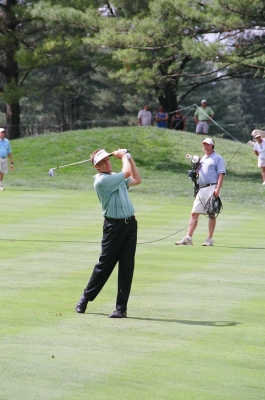 |
| Stuart Appleby showing his Leaderboard form on the fairways. |
Appleby reveals his Leaderboard routine: �I�ll do some drills, some swings in the gym � either with a club or without one� and just swing. It turns on the groups of muscles that enable me to rotate more. When you rotate with really good form and put the club down the line, the slot, you�re guaranteed to hit the ball farther. That�s a bit of clich�, but it�s 100 percent true.�
�I�ll use it in the morning, and then in the afternoon I do the same thing, probably five minutes each. And if I feel the need or maybe my swing�s a bit out of shape, I�ll spend some time on the range. It�s not something you have to spend a lot of time on, because your results, all the feeling of the pattern you�ve changed easily and very quickly,� Appleby concluded.
You can also use the Leaderboard for putting and chipping, which certainly will force you to keep your lower body �quiet� during those shots.
For those with the time, means, curiosity and dedication, the Leaderboard can be a helpful tool. It does come with a 6-week satisfaction guarantee, so it�s certainly worth a try for those looking for just that little extra bit of �feel� to groove the complexities of the golf swing.
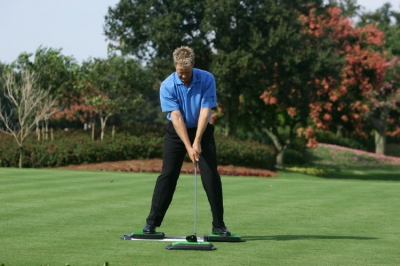 |
Details:
Congratulations to 2006 United States Open Champion Geoff Ogilvy, who endorses the Leaderboard.
For product information go to http://www.leaderboard.tv/
| Related Links | Comments on this article? | |
|
Maryland National Golf Club Hollow Creek Golf Club Rocky Gap Resort PB Dye Golf Club in Ijamsville Whiskey Creek Golf Club |
E-mail Jeff Rendall, Editor: jrendall@golftheunitedstates.com |












